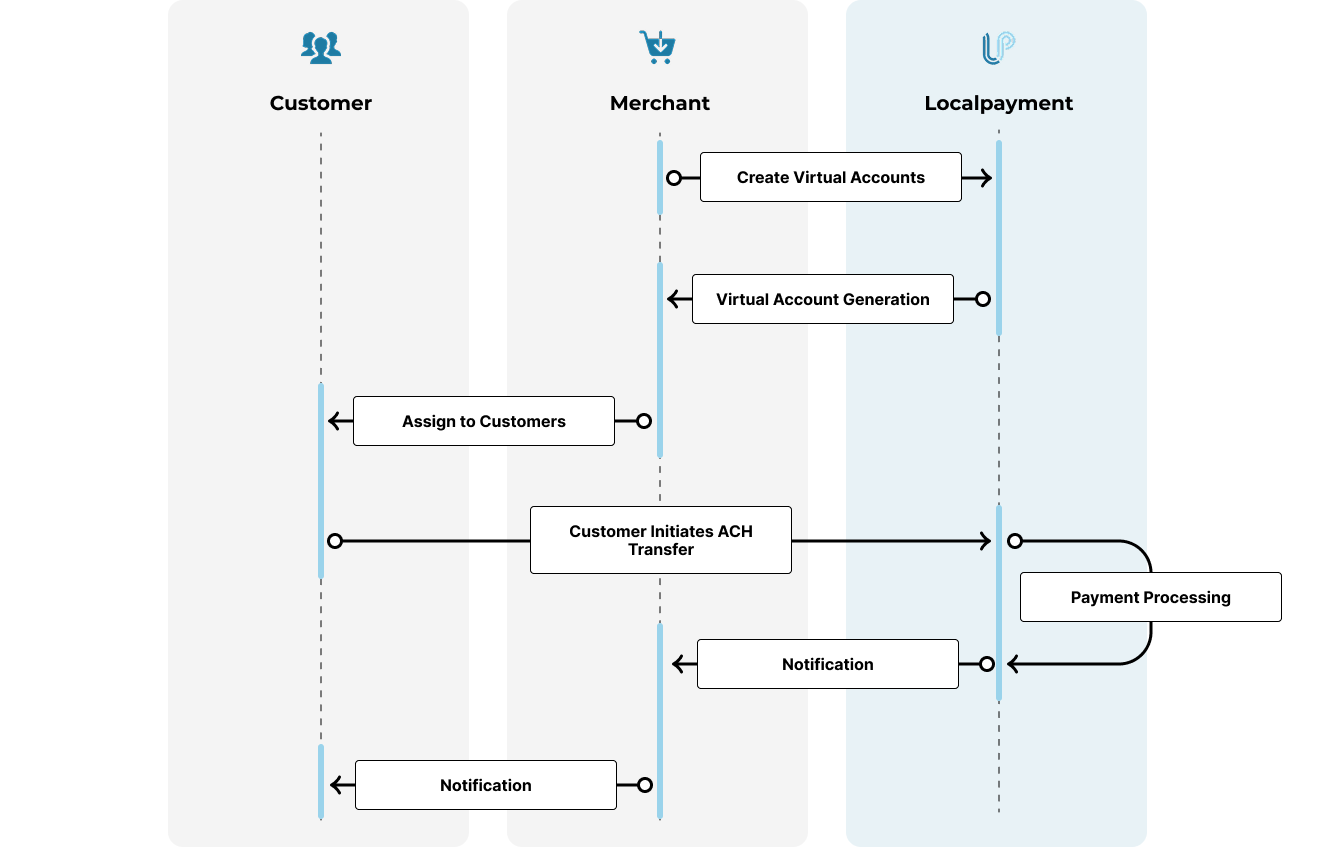Virtual Accounts Overview
Introduction to Virtual Accounts
Virtual accounts are unique, system-generated bank account numbers that facilitate secure and organized payment processing between businesses and their customers. Think of them as temporary, purpose-specific bank accounts that act as intermediaries in financial transactions. Unlike traditional bank accounts tied to a specific entity, virtual accounts are created on-demand for specific transactions, customers, or use cases, then deactivated once their purpose is fulfilled.
When a customer needs to make a payment, your system generates a dedicated virtual account number specifically for that transaction or customer. The customer then transfers funds to this virtual account from their regular bank account. The payment platform automatically matches incoming funds to the correct virtual account and updates your system in real-time, completing the payment cycle seamlessly.
Supported Countries & Coverage
Virtual account processing is available in the following countries:
Use Cases
B2B Payments and High-Value Transactions
Virtual accounts excel in business-to-business scenarios where transaction amounts are significant and proper documentation is crucial. Each virtual account can be associated with a specific invoice, project, or client, creating an automatic audit trail that simplifies reconciliation. Large corporations use virtual accounts to manage payments from multiple departments or subsidiaries while maintaining clear financial separation.
Wallets / Fintechs
Digital wallets and fintech platforms use virtual accounts as core banking infrastructure, providing each user with unique account numbers for deposits and withdrawals without traditional banking overhead. This enables 24/7 operations, instant account provisioning, and scalable management of millions of accounts while maintaining bank-grade security and regulatory compliance through API-driven architecture.
Cross-Border Transactions
For international transactions, virtual accounts denominated in local currencies help businesses avoid foreign exchange complications and reduce cross-border payment fees. Customers pay in their local currency to a local virtual account, while merchants receive funds in their preferred currency.
Lending / Remittances
In lending, virtual accounts manage loan disbursements and organized repayments through dedicated accounts for each borrower, creating clear audit trails and automated reconciliation. For remittances, they facilitate cross-border transfers with better exchange rates, enabling recipients to access funds through multiple channels while providing complete transaction tracking and regulatory compliance automation.
How It Works
The process of using virtual accounts through Localpayment involves the following steps:
- Create Virtual Accounts: The merchant initiates the process by creating virtual accounts through Localpayment. Each virtual account is uniquely generated to facilitate individual tracking.
- Virtual Account Generation: Localpayment automatically generates a unique virtual account and sends the account details.
- Assign to Customers: Each virtual account is assigned to a specific customer, ensuring that incoming payments can be accurately attributed to the correct source.
- Customer Initiates ACH Transfer: Customers perform local ACH bank transfers, directing funds to their assigned virtual account numbers. This method ensures that payments are routed correctly without the need for additional identifiers.
- Real-Time Reconciliation: Upon receipt, payments are automatically reconciled in real-time. Localpayment's system performs automatic matching of incoming funds to the designated virtual accounts, with immediate updates to transaction records.
- Notification: Merchants receive instant notifications for successful payments. These alerts confirm transactions and provide key details for efficient financial management.

Prerequisites
Before creating your first virtual account, ensure you have completed the following essential steps:
Implementation Guide
Implementing virtual accounts for payment processing not only simplifies transactions but also enhances security and operational efficiency. Below are some of the latest best practices and trends to consider when implementing virtual accounts on your platform.
Create a Virtual Account
Generate unique virtual account numbers via API for individual customers or transactions. Programmatically set amounts, expiration dates, and custom references for automated payment tracking.
Offline Virtual Account Creation
Create virtual accounts without API integration using dashboard tools or batch uploads. Ideal for one-time setups or manual operations.
Get Virtual Account Status
Retrieve current status and details of any virtual account. Monitor active accounts and verify account configuration in real-time.
Activate/Deactivate Virtual Account
Temporarily suspend or reactivate virtual accounts without deleting them. Perfect for pausing payments during disputes or customer service cases while preserving account data.
Delete Virtual Account
Permanently remove virtual accounts and associated data. Use for cleaning up completed transactions or accounts that are no longer needed.
Receive Payment Notifications
Configure webhooks to get instant payment confirmations when customers transfer funds. Automatically update order statuses and trigger fulfillment processes upon successful payments.
Manage Virtual Account Aliases
Add memorable aliases to virtual accounts for easier customer identification. Simplify payment references while maintaining unique account numbers.
Virtual Account Operations
Once a virtual account is successfully created and active, various operational workflows can be managed throughout its lifecycle to optimize payment collection and customer experience. The available operations depend on the account status, transaction requirements, and specific business needs. Here's an overview of the key operational capabilities:
| Country | Status | Activate / Deactivate | Delete | Alias | Webhooks |
|---|---|---|---|---|---|
| Argentina | ✔ | ✔ | ✔ | — | ✔ |
| Brazil | ✔ | ✔ | ✔ | ✔ | ✔ |
| Mexico (SPEI) | ✔ | ✔ | ✔ | — | ✔ |
| Mexico (TEF) | ✔ | — | ✔ | — | ✔ |
| Peru | ✔ | ✔ | — | — | ✔ |
Updated 3 days ago
